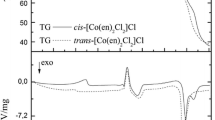Abstract
Samples of an organic–inorganic hybrid were prepared by solvolysis and polycondensation in formic acid of tetraethoxysilane and diethylbenzyl phosphonate, simultaneous with the oxidative polymerization of aniline. The thermal behavior of the samples in dynamic air atmosphere and non-isothermal conditions was determined by a coupled thermogravimetric/evolved gas analysis. Two significant thermal events were established: the elimination from the polymeric matrix of low mass molecules, respectively the thermooxidative degradation of the organic part of the matrix. The kinetic analysis was performed with the Flynn-Wall-Ozawa, Friedman and modified Non-Parametric-Kinetic methods. Only the last one allowed an objective analysis of the first process as a process of two simultaneous thermally induced phenomena with the kinetic functions of the type αm(1 − α)n.







Similar content being viewed by others
References
Judeinstein P, Sanchez C. Hybrid organic–inorganic materials: a land of multidisciplinarity. J Mater Chem. 1996;6:511–26.
Loy DA, Shea KJ. Bridged polysilsesquioxanes. Highly porous hybrid organic-inorganic materials. Chem Rev. 1995;95:1431–42.
Sanchez C, Ribot F, Lebeau B. Molecular design of hybrid organic-inorganic nanocomposites synthesized via sol-gel chemistry. J Mater Chem. 1999;9:35–44.
Judeinstein P, Livage I, Zarudiansky JA, Rose R. An “all gel” electrochromic device. Solid State Ionics. 1988;28–30:1722–5.
Mutin PH, Guerrero G, Vioux A. Organic–inorganic hybrid materials based on organophosphorus coupling molecules: from metal phosphonates to surface modification of oxides. C.R. Chimie. 2003;6:1153–64.
Matsunaga T, Doifuku H, Nakajima T, Kawagoe T. Development of polyaniline-lithium secondary battery. Polym Adv Technol. 1990;1:33–9.
Duek EAR, De Paoli M-A, Mastragostino M. An electrochromic device based on polyaniline and prussian blue. Adv Mater. 1992;4:287–91.
Santhiyanarayanan S, Muthukrishnan S, Venkstachari G, Trivedi DC. Corrosion protection of steel by polyaniline (PANI) pigmented paint coating. Prog Org Coat. 2005;53:297–301.
Boonstra AH, Bernardes INM. The dependence of the gelation time on the hydrolysis time in a two-step SiO2 sol-gel process. J Non Cryst Solids. 1988;105:207–13.
Mattes BR, Knobble ET, Fuqua PD, Nishida F, Chang EW, Pierce BM. et al. Polyaniline sol-gels and their third-order nonlinear optical effects. Synth Met. 1991;43:3183–7.
de Azevedo WM, Brondani DJ. Formic acid an efficient solvent to prepare polyaniline/silicate glass composite using sol–gel technique. J Non Cryst Solids. 2001;296:224–9.
Ita M, Uchida Y, Matsui K. Polyaniline/silica hybrid composite gels prepared by the sol-gel process. J Sol-Gel Sci Technol. 2003;26:479–82.
Panitz IC, Wokaum A. Characterization of the sol-gel process using raman spectroscopy organically modified silica gels prepared via the formic acid-alkoxide route. J Sol-Gel Sci Technol. 1997;9:251–63.
Sharp GK. A two-component, non-aqueous route to silica gel. J Sol-Gel Sci Technol. 1994;2:35–41.
Brown ME, Maciejewski M, Vyazovkin S, Nomen R, Sempere J, Burnham A, et al. Computational aspects of kinetic analysis: Part A: The ICTAC kinetics project-data, methods and results. Thermochim Acta. 2000;355:125–43.
Vlase T, Doca N, Vlase G, Bolcu C, Borcan F. Kinetics of non-isothermal decomposition of three IRGANOX-type antioxidants. J Therm Anal Calorim. 2008;92(1):15–8.
Flynn IH, Wall LA. A quick, direct method for the determination of activation energy from thermogravimetric data. Polym Lett. 1966;4:323–8.
Ozawa T. A new method of analyzing thermogravimetric data. Bull Chem Soc Jpn. 1965;38:1881–6.
Friedman HL. Kinetics of thermal degradation of char-foaming plastics from thermogravimetry: application to a phenolic resin. J Polym Sci. 1965;6C:183–95.
Serra R, Nomen R, Sempere J. The non-parametric kinetics a new method for the kinetic study of thermoanalytical data. J Thermal Anal Calorim. 1998;52:933–43.
Sempere J, Nomen R, Serra R. Progress in non-parametric kinetics. J Thermal Anal Calorim. 1999;56:843–9.
Vlase T, Vlase G, Birta N, Doca N. Comparative results of kinetic data obtained with different methods for complex decomposition steps. J Thermal Anal Calorim. 2007;88(3):631–5.
Vlase T, Vlase G, Doca N, Bolcu C. Comparative kinetic analysis with NPK method. J Thermal Anal Calorim. 2005;80:59–64.
Vlase T, Vlase G, Doca N. Thermal stability of food additives of glutamate and benzoate type. J Thermal Anal Calorim. 2005;80:425–8.
Vlase T, Vlase G, Doca N. Kinetics of thermal decomposition of alkaline phosphates. J Thermal Anal Calorim. 2005;80:207–10.
Ioiţescu A, Vlase G, Vlase T, Doca N. Kinetics of decomposition of different acid calcium phosphates. J Thermal Anal Calorim. 2007;88(1):121–5.
Vlase T, Vlase G, Modra D, Doca N. Thermal behaviour of some industrial and food dyes. J Thermal Anal Calorim. 2007;88(2):389–93.
Vlase G, Vlase T, Doca N. Thermal behavior of some phenitoine pharmaceuticals. J Thermal Anal Calorim. 2008;92(1):259–62.
Birta N, Doca N, Vlase G, Vlase T. Kinetic of sorbitol decomposition under non-isothermal conditions. J Thermal Anal Calorim. 2008;92(2):635–8.
Doca N, Vlase G, Vlase T, Ilia G. Thermal behavior of Cd2+ and Co2+ phenyl-vinyl-phosphonates under non-isothermal condition. J Thermal Anal Calorim. 2008;94(2):441–5.
Wall ME. ME. Singular value decomposition and principal component analysis. In: Berrar DP, Dubitzky W, Granzow M, editors. A practical approach to microarray data analysis, vol. 9. MA: Kluwer-Norwel; 2003; p. 91-109. LANL LA-UR-02.
Šesták J, Berggren G. Study of the kinetics of the mechanism of solid-state reactions at increasing temperatures. Thermochim Acta. 1971;3:1–12.
Author information
Authors and Affiliations
Corresponding author
Rights and permissions
About this article
Cite this article
Vlase, G., Vlase, T., Doca, N. et al. Thermal behavior of a sol–gel system containing aniline and organic phosphonates. J Therm Anal Calorim 97, 473–478 (2009). https://doi.org/10.1007/s10973-009-0216-z
Published:
Issue Date:
DOI: https://doi.org/10.1007/s10973-009-0216-z




